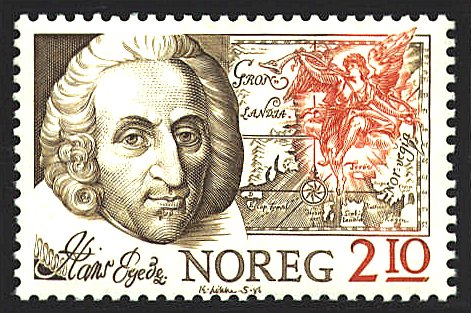|
In 1721 the Danish king
provided financial support for an expedition under the leadership of
the Norwegian priest, to Greenland to convert the Greenland Vikings to
Christianity. However, though the king did not know it the Viking
settlements on Greenland had disappeared by the beginning of the
fifteenth century because of increasingly severe winters. Hans Egede
turned his missionary attention to the native population, and
established a Scandinavian colony.
Egede was an
educator, author, natural historian and cartographer, in addition to
his ecclesiastical office. Soon after he returned to Copenhagen in
1737 he drew a map of Greenland, the oldest surviving map drawn by an
inhabitant. The map on the stamp may also be by Egede.

An
interesting feature of the stamp is the national designation Noreg.
While there are some countries (Canada for example) which have more
than one national language, Norway has only one language, but two
expressions of it. Riksmal or Bokmal was the official language of
Norway until 1885. Its spelling and grammar are largely Danish, and
reflects the long Danish rule in Norway. Ivar Aasen devised Landsmal
or Nynorsk based on the dialects of western Norway. In 1885 it was
given equal standing with Bokmal. In practice local custom determines
how place names are to be pronounced.
The name of the
country also occurs in two versions, Norge in Bokmal and Noreg in
Landsmal. Both spellings occur on Norwegian stamps. Although the use
of one version or the other does not seem to have any logic to an
outsider, it probably has to do with the subject of the stamp, and the
use of one or other language expression in connection with that
subject.


 |
